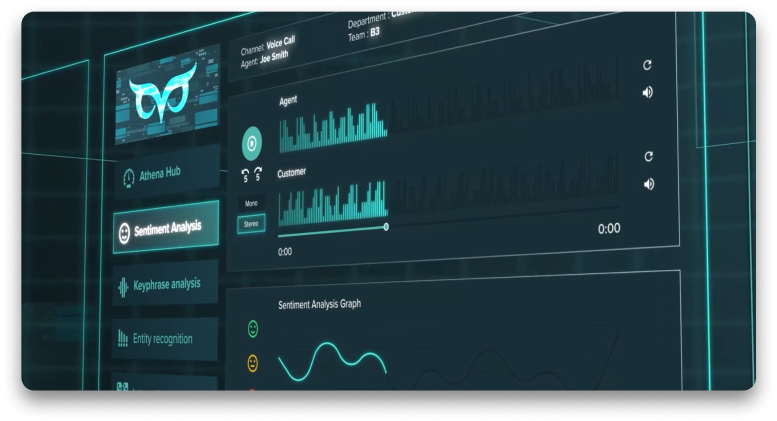AI Based Contact Center
Over the last couple of years, Artificial Intelligence has proven to be an invaluable asset for businesses in the customer engagement domain looking to streamline their operations and maintain a decisive competitive edge. Today, it seems more self-evident than ever that the AI Based Contact Center is the customer service paradigm of the future, and only businesses that succeed to adapt to the new landscape shaped by the impact of AI will remain competitive.
But how can businesses prepare for the task of embracing the new AI Based Contact Center model and ensure they’re prepared to thrive in the fast-paced and ever changing ecosystem of customer engagement and Artificial Intelligence? While any tailored response will vary depending on the specific needs and pain points of each company, it’s possible to sketch a list of essential features and tools for the AI Based Contact Center of the future and explain what makes them so important. That’s what we’ll do in this article.
7 Essential AI Based Contact Center Tools
Predictive Dialler
Predictive Diallers leveraging AI algorithms are especially useful for contact centres with significant volumes of outbound interactions. A Predictive Dialler stands apart from other types of diallers due to its utilization of sophisticated statistical algorithms and Artificial Intelligence (AI) to anticipate agent availability and initiate multiple calls simultaneously. While traditional diallers adhere to pre-set strategies determined by human agents, Predictive Diallers autonomously adjust pacing and strategy by analyzing call data. By avoiding occupied agents and filtering out busy signals, no-answers, and disconnected numbers, Predictive Diallers ensure agents are exclusively connected to answered calls, maximizing efficiency, reducing wasted time, and increasing conversation time with responsive customers. This leads to enhanced agent productivity, time efficiency, and ultimately, more successful connections and conversions per agent and day.
A predictive dialler works following a series of steps. It begins by utilizing predictive algorithms to forecast agent availability and initiates concurrent dialing of multiple numbers, surpassing the count of available agents, as some calls are anticipated to be unanswered, busy signals, or voicemails. Then, the dialler sieves out unanswered calls and links live calls to accessible agents to minimize idle time.
After that, predictive dialler software relies on mathematical algorithms to guide dialing decisions aligned with business objectives. These algorithms consider various factors, including typical conversation durations, call handling times per team, outbound call attempts to reach a human recipient, customer abandonment rates for unanswered calls, current agent availability within the organization, and the potential need for agents to initiate callbacks. Leveraging this data, the predictive dialler anticipates agent availability and commences calls on their behalf.
By simultaneously dialing multiple numbers, the system furnishes agents with a continual flow of calls, reducing downtime and eliminating the need for manual searching through contact lists or waiting for the next call. In instances of unanswered calls, the predictive dialler moves on to the subsequent number in the contact list. During periods of peak activity, it can adjust its pace or temporarily pause operations until agents are nearing the conclusion of their ongoing calls.
Intelligent Call Routing and Workflow Automation
In traditional contact centers, a significant portion of agents’ time is consumed by mundane tasks such as searching for client information or routing calls to relevant departments. According to a study conducted by IBM, these tasks may occupy up to 75% of an agent’s daily workload. This not only leads to prolonged wait times, which are frustrating for customers and resource-intensive for businesses, but also contributes to agent burnout, resulting in increased agent turnover. Consequently, replacing staff entails substantial investments of time and resources.
By implementing workflow automation, these challenges can be effectively addressed, streamlining processes and maximizing productivity. Utilizing the appropriate software tool enables the automation of tasks that divert agents’ attention from serving customers. Advanced AI tools can automate various tasks, including call sorting and routing, as well as transferring information from databases directly to agents’ screens.
Certain AI Based Contact Center platforms, equipped with workflow automation capabilities, can streamline the entire call routing process by seamlessly linking different touchpoints based on rules tailored to business and customer preferences. Using AI features like Keyphrase Analysis and Automatic Speech Recognition, queries can be categorized and directed based on factors such as channel, required skills, language, or specific keywords.
Workflow automation proves particularly advantageous for businesses handling high volumes of queries with diverse skill requirements, ensuring that each interaction is promptly directed to the appropriate team for smooth, swift, and fruitful conversations for both representatives and customers.
Conversational AI
Incorporating Conversational AI into Omnichannel Software offers a powerful solution for businesses seeking operational streamlining and enhanced customer interactions. This technology effectively manages routine inquiries, automating responses, and directing customers to relevant resources, thereby liberating human agents to focus on high-value, complex interactions. Industries dealing with substantial volumes of routine queries, such as e-commerce, customer support, and financial services, can greatly benefit from this technology.
By entrusting routine interactions to AI-driven systems, businesses can achieve quicker response times, reduce operational expenses, and elevate the overall customer experience. This enables human agents to dedicate their efforts to more strategic and value-added activities. Whether a small startup seeks cost-effective customer support or a large enterprise aims to optimize efficiency and customer engagement, Conversational AI emerges as an indispensable asset for businesses pursuing these objectives.
Sentiment Analysis
Sentiment analysis, also known as opinion mining, utilizes AI algorithms and natural language processing (NLP) to analyze human emotions, attitudes, and opinions expressed in textual data. Its primary goal is to determine whether a piece of text conveys a positive, negative, or neutral sentiment. This tool has found widespread applications across various sectors, particularly in customer service, where it helps decipher the sentiment behind customer feedback, reviews, and social media posts. By understanding the emotional tone of these interactions, businesses gain valuable insights into customer satisfaction, identify pain points, and tailor their strategies accordingly.
Sentiment analysis plays a crucial role in enhancing customer engagement and satisfaction across various aspects of business operations. By monitoring social media, reviews, and direct interactions, companies can grasp the overall sentiment of their customer base and proactively engage with them. This enables businesses to respond promptly to both positive and negative sentiments, reinforcing customer loyalty and showcasing a commitment to satisfaction.
Moreover, sentiment analysis helps businesses understand individual customer preferences and emotions, enabling personalized interactions that foster stronger connections between customers and brands. By being proactive in monitoring sentiments across various channels, companies can address customer concerns before they escalate, demonstrating a commitment to customer-centricity. Additionally, sentiment analysis provides valuable insights for continuous improvement by identifying recurring themes in customer sentiments, allowing businesses to refine products or services and enhance overall customer satisfaction. This data-driven approach enables companies to stay agile and responsive to evolving customer expectations.
Intelligent Call Analytics
Certain AI Based Contact Centre tools offer the functionality to comprehensively track and monitor customer behavior and sentiment by analyzing their interactions with agents, providing valuable insights into both customer behavior and staff performance. This insight aids in gaining a better understanding of how customers perceive the business, their preferences, and areas for potential improvement in strategies and operations.
By consolidating data from various communication channels such as phone, email, social media, or SMS, call centers can develop a profound understanding of their strengths and pain points, thus facilitating the enhancement of strategies. As mentioned, AI Sentiment Analysis can enable businesses to tailor their approach based on customer preferences and satisfaction levels. Moreover, AI tools like Sentiment Analysis, Keyphrase Analysis, or Entity Recognition can uncover trends and patterns, empowering businesses to make data-driven decisions that enhance operational efficiency and cost-effectiveness.
Forecasting
Forecasting features within an AI Based Contact Center platform introduces strategic planning capabilities that significantly enhance an organization’s ability to synchronize its workforce with dynamic business demands. By employing advanced algorithms and historical data, forecasting becomes a potent tool for predicting future workload trends, facilitating proactive decision-making.
One key advantage is the accurate anticipation of staffing requirements. Through forecasting, organizations can predict peak work periods, seasonal fluctuations, and other trends influencing workforce needs. This empowers managers to strategically schedule shifts, allocate resources efficiently, and ensure an appropriate staff level to meet demand, thereby minimizing the risks of understaffing or overstaffing and optimizing operational efficiency.
Moreover, forecasting enables the alignment of workforce planning with overarching business objectives. By anticipating demand fluctuations, organizations can adjust staffing levels to support growth, scale operations during busy periods, or implement cost-saving measures during slower times. This strategic alignment enhances adaptability, enabling businesses to respond effectively to shifting market conditions.
ASR IVR
The integration of Automatic Speech Recognition (ASR) technology into Interactive Voice Response (IVR) systems revolutionizes customer phone interactions by enabling precise transcription and comprehension of spoken words. This advancement not only enhances communication clarity but also facilitates effortless navigation through IVR menus, providing customers with a seamless experience.
Moreover, ASR technology streamlines the process of automated data entry, minimizing the necessity for manual input during customer calls. Consequently, the incorporation of ASR into IVRs significantly boosts the efficiency of phone-based customer service operations, ultimately leading to a more streamlined and satisfactory customer experience overall.
If you enjoyed reading this, you might also be interested in…
Customer Service AI
Conversational AI
Contact Center Artificial Intelligence
AI Agent



